Este post também está disponível em:
Português
English
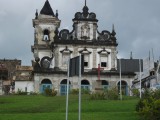
Cairu Archipelago with its main islands Cairu, Boipeba and Tinharé offers beautiful landscapes, beaches and lots of culture.
Cairu is a Brazilian municipality in the state of Bahia.
This island municipality is the Tinharé or Cairu Archipelago itself, composed of 26 islands located in an estuarine complex, where the main islands are those of Cairu, Boipeba and Tinharé.
In all, there are three villages (Galeão, Gamboa and Velha Gamboa), six towns (Morro de São Paulo, Canavieiras, São Sebastião, Torrinhas, Tapuias and Garapuá) and one city – Cairu.
The primitive name of the island of Cairu was Aracajuru, “house of the sun” in the indigenous language.
Cairu emerged in the 16th century, during the settlement of the Captaincy of Ilhéus. It was one of the most important villages of the Colony.
The town was elevated to the category of village in 1610 and in 1938 to city.
In the eighteenth century, it was considered the best and safest place to live in the region, and was the home of the ombudsmen and courtiers of the Ilhéus Chamber.
Cairu is an archipelago?
It is important to reinforce this information, since, not rarely, you may find content that places Cairu as an island-municipality, and claims that Tinharé is the real archipelago.
As far as the archipelago in this region of the Southern Bahia Lowlands is concerned, it is Cairu.
Videos about Cairu in Bahia
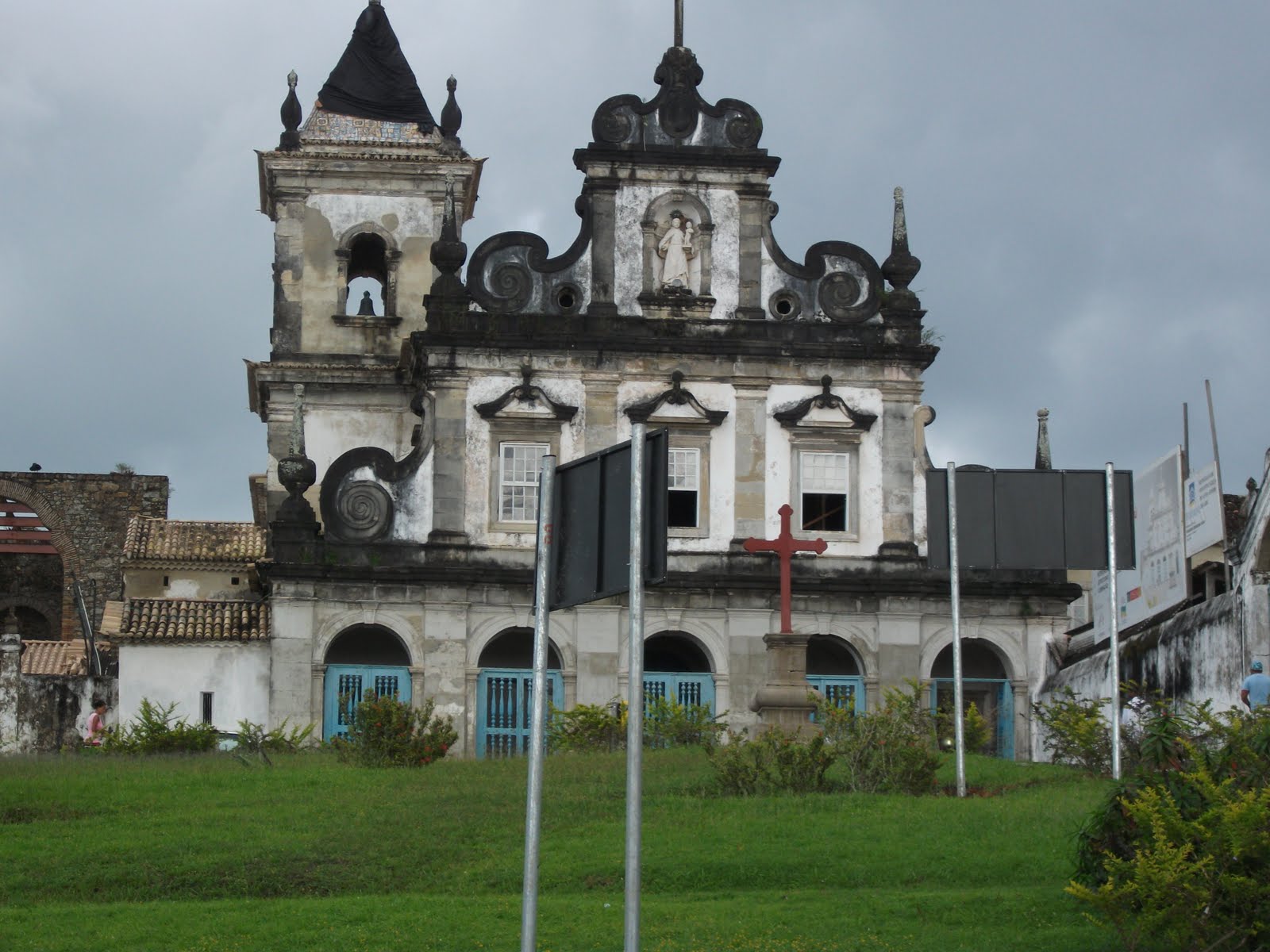

Convento e Igreja de Santo Antonio em Cairu

Cairu na Bahia - Drone
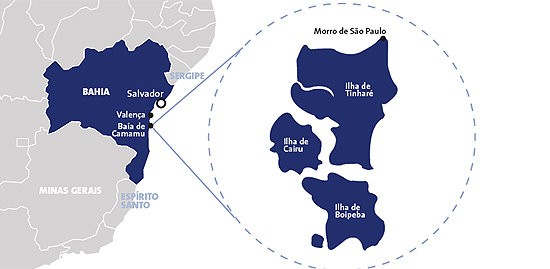
Arquipélago de Cairu - Pontos Turísticos 25:49

Praia de Moreré na Ilha de Boipeba02:37

Praia de Tassimirim na Ilha de Boipeba02:56

Praia de Cueira na Ilha de Boipeba02:33

Morro de São Paulo na Ilha de Tinharé15:05

Praia de Garapuá na Ilha de Tinharé02:17

Povoado do Galeão em Tinharé04:47

Praia de Bainema em Boipeba02:14

Praia Boca da Barra na Ilha de Boipeba02:29

Gamboa do Morro na Ilha de Tinharé01:10
A. Tourist points of the city of Cairu
1. Nossa Senhora do Rosário Church
It is located on the island of Cairu and is divided into the upper town, where the city was born, and the lower town.
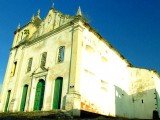
In the upper town there are some buildings of historical importance, such as the Church of Our Lady of the Rosary (1610) located on an elevation looking towards the Convent of Cairu.
From the top you can enjoy a beautiful view of the region.
The surrounding low houses form a pleasant ensemble.
Don’t miss the images of Nossa Senhora do Rosário, Nossa Senhora das Dores, São José and São Miguel.
Also very beautiful are the windows in the sacristy made of sandstone ashlar.
There are also two-storey houses with attics and, at the entrance to the town, the old town hall, possibly dating from the late 18th century.
2. Convent of Santo Antônio and Historic Center

Erected where there was a small chapel invoking Saint Anthony, are the Church and Convent of Saint Anthony whose façade, preceded by a stone cross, faces the arm of the sea that separates the islands of Tinharé and Boipeba.
To the left of the Church of Saint Anthony are the ruins of the chancel of the Third Order, which was never completed.
The construction of this convent, built by the Capuchins, dates back to 1654 and a precious set of Portuguese tapestry tiles from the 17th and 18th centuries still exists today.
From the belvederes on the second floor you can enjoy a beautiful view of the sea and the countryside.
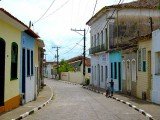
In the early seventeenth century, the Franciscans who received, by donation, “the sesmaria of the twelve leagues of Camamu”, built in Cairu the Residence of St. Francis Xavier (Galeão – 1623) and the Church of St. Ignatius.
At the beginning of the 18th century, the exploitation of the forests began to rival the production of flour in the region.
Cairu was a traditional supplier of flour to the capital.
It is interesting to mention that for three decades Cairu contributed financially to the reconstruction of Lisbon, devastated by a great earthquake in 1756.
It dates from this time the emergence of quilombos created by fugitive blacks.
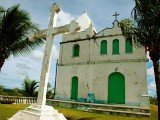
In 1870, timber cutting was so intense and generated so much profit that the government had to create the position of Judge Corregedor das Matas to stop uncontrolled predatory exploitation.
Twenty years later, given the ineffectiveness of this measure, the Crown decided to tumble what remained of the forests, to stop the exploitation of wood on the islands.
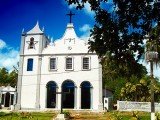
The city of Cairu has a good tourist infrastructure, with hotels, inns, restaurants and mooring for charter boats to Valença, Boipeba (the journey takes 40 minutes by speedboat or 2 hours by boat) and other destinations on the Taperoá Canal.
Surrounded by mangroves, Cairu has no good beaches for swimming.
Coconut and piassava are the basic elements of handicrafts which, together with religiosity, fishing and shipbuilding, are a reflection of the past experienced on these islands. Also noteworthy are the cultivation of cloves, black pepper and guaraná.

About 30 years ago the island was connected to the mainland by a bridge.
Local folklore keeps alive the memory of indigenous ancestry, slavery, military presence, struggles in defense of the nation, nostalgia for Portugal, Spain, Holland and Angola.
The representations of the congos, taeiras, dondoca, alardo, zambiapunga, chegança, bumba-meu-boi and barquinha cinza remain very much alive.
The city is surrounded by mangroves and reserves points for diving especially in the Benedita, Tatiba and Tatimirim Rocks.
B. Tourist Attractions of the Cairu Archipelago
The most popular attraction in the municipality of Cairu is the Morro de São Paulo which is well known for having beautiful beaches with crystal clear waters.
The island of Tinharé is a beautiful setting with lots of beauty and a beautiful sea.
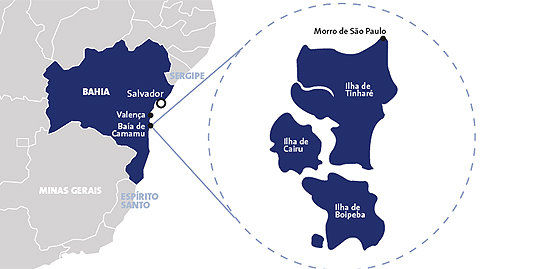
See the map of the Costa do Dendê
Cairu is a city that offers besides beautiful landscapes a lot of culture, for its residents and visitors, and has the advantage of being a quiet place with a very welcoming people.
We also have the region of Boipeba which is an island of the Tinharé archipelago, in the Lower South of Bahia and is considered as one of the oldest colonizations.
The foundation of the Village and Resistance of Boipeba happened in 1537, by the Jesuits.
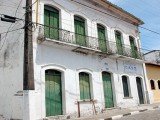
On one side, the island is bathed by the ocean, and on the other by the estuary of Rio do Inferno.
It has immense natural beauty and great diversity of ecosystems. It is one of the oldest colonization sites in Bahia.
This island has more than 20 km of deserted beaches, with blue sea and natural pools.
Those who go to Boipeba are willing to walk barefoot and exchange comforts for proximity to nature. The main village is Velha Boipeba, in Boca da Barra.
The ecosystem of the island encompasses the most varied formations; being composed of dense forest of the Atlantic Forest, sand dunes, mangroves and paradisiacal beaches with coconut trees and reefs. These reefs extend along the coast, making the beaches sheltered from waves and currents.
Its flora and fauna are rich with a great variety of corals, algae, fish, molluscs, urchins, stars and others.
In addition, there are sea turtles in the region, which lay their eggs on several beaches of the island.
The predominant economic activity on the island is fishing, in addition to fish, crabs, crab, lambreta, guaiamu and especially shrimp are caught and marketed.
The agricultural crops that stand out on the island are coconut and palm oil. Tourism as an economic activity is very recent on the island.
The only access to this paradise is by sea or river, so the tranquility, peace and environmental conservation of the area, causes the motivation of ecological tourism, in this place of kilometers of deserted beaches, swimming pool in the open sea and lots of nature.
Its paradisiacal beaches are known throughout Brazil, one of its main ones being Boca da Barra, where it has a large hotel structure and is close to the village of Velha Boipeba.
One of the unforgettable walks on the island is to Tassimirim and Cueira beach, the only one on the island with some waves. Due to so many natural beauties, tourism only tends to grow.
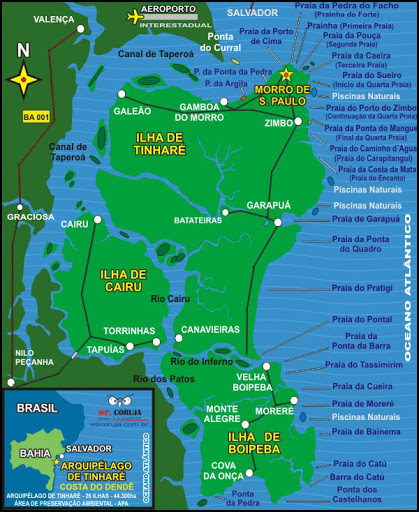
1. Moreré Beach
The main attraction of Boipeba Island the natural pools of Moreré is the perfect place for snorkeling, crystal clear waters, reefs, corals and small fish makes the place very special.
With all its beauty the natural pools of Moreré is located a few kilometers from the coast and is one of the most sought after places of the Ilha de Boipeba, crystal clear and warm waters with varieties of coral reefs provides you with a relaxing environment that makes you forget the hustle and bustle of big cities, but the main attraction is the little fishes of name capiaçava that already accustomed to the presence of the tourist provides you a dive very close to them.
The natural pools are ideal for practicing scuba diving (snorkeling and diving mask), being able to appreciate more closely the riches of the seabed.
2. Tassimirim Beach
An almost untouched beauty, Tassimirim Beach on Boipeba Island is surrounded by coconut trees and natural pools.
Tassimirim Beach is usually much quieter, compared to its neighbor Cueira, for example. Therefore, those who want a quiet corner, to spend really quiet hours, can head there without fear of being disappointed.
3. Cueira Beach
One of the best places to bathe in the sea on Boipeba Island, Cueira Beach is not so far from the village of Velha Boipeba and is worth the visit.
There are plenty of beautiful beaches around here, but this one stands out for its coconut trees and the good structure to spend the day.
It is the best of the island for swimming, with calm sea. On the long shore, the cliffs and rocks are only on the sides, far away from bathers. In the left corner, surfers swarm. The coconut trees provide the necessary shade on the sand.
4. Morro de São Paulo
Morro de São Paulo is a small destination, full of charm and enchanting for its natural beauty and good nightclubs. Morro de São Paulo attracts both travelers who want days of rest on the beach and partygoers who enjoy the night and party without an hour to end.
The beaches are the main attractions and to explore each of them you can choose between walks by the sea, speedboat rides, quad bike routes and delicious bike routes through the sand. Some of them have natural pools, others attract by the deserted strip of sand, good waves for practicing sports and even the nightlife, which in Morro happens both day and night.
Located very close to the center of Morro de São Paulo, between Morro do Farol and Segunda Praia, Primeira Praia is famous for being the arrival point of the Morro de São Paulo zip line.
It is in the waters of the First Beach that you will arrive as you venture down the 350-meter-long descent of the longest zip line in Brazil.
4.1. First Beach
Although it is not among the favorites of tourists, the First Beach – which is only 310 meters long – is a great choice to enjoy swimming and also the practice of sports, since this is the only beach in Morro de São Paulo with good waves.
4.2. Second Beach
The Second Beach of Morro de São Paulo is the most popular among tourists visiting the island. Lively, full of bars and restaurants, with several good inns and an always spectacular sea, it is one of the best to enjoy both day and night.
With just under 400 meters long, it has a wide strip of sand, white sand and usually has a very calm sea. During low tide it is even possible to enjoy some natural pools that form there.
To enjoy the day at Segunda Praia, it is worth taking advantage of the delicious sea for a good swim; stroll through the vegetation of Ilha da Saudade; take advantage of the wide strip of sand to practice sports, such as volleyball, frescobol, soccer and others; climb to the lookout for a beautiful photo; and, of course, try the good dishes served by local restaurants. At night, the best thing to do is to enjoy the lively bars by the sea.
4.3. Terceira Beach
The Third Beach of Morro de São Paulo marks the passage from the excitement of the Second Beach to the calm of the Fourth Beach. That is why it is ideal for those who want to be in a quieter environment, but without being too far from the hustle and bustle of Morro de São Paulo.
With about 800 meters long, the Third Beach has the beautiful scenery of Saudade Island on the left and delicious natural pools in the right corner.
The look of the beach changes a lot according to the tide, since at high tide a good part of the strip of sand disappears, while at low tide the corals and pools appear.
4.4. Fourth Beach
The Fourth Beach of Morro de São Paulo is the right place to stay away from the movement and enjoy the beautiful natural scenery of the island. With 4 km of sand strip and permeated with beautiful formations of natural pools, Quarta Praia is an invitation to isolate and relax.
The infrastructure is limited to the beginning of the sand strip (near the Third Beach), where the natural pools that appear at low tide are located. Further on, you will find small stretches with movement, where some of the hotels and resorts of Quarta Praia are located, among them the famous Patachocas.
Due to its large extension and more distant access, Quarta Praia is never crowded. It is a great choice for days when Morro de São Paulo is very busy.
4.5. Fifth Beach
The Fifth Beach, or Praia do Encanto, is one of the most isolated and difficult to access in Morro de São Paulo. Far from all the hustle and bustle of the island, it is the right place for those who want tranquility, intense contact with nature and, if the budget allows, an incredible and unforgettable accommodation by the sea.
There are almost 2 km of sand strip practically deserted. A paradise!
5. Garapuá Beach
Garapuá is a super quiet village with rustic houses in the Tinharé Archipelago, not far from Morro de São Paulo.
Its beach is considered by many the most beautiful place in the whole region and is definitely a tour that cannot be left out of your trip.
Located after Quinta Praia and 14 km from the center of Morro de São Paulo, Garapuá may not be the easiest place to visit, but it is certainly among the must-see tours for those in Morro.
Garapuá Beach is 2 km long and has a beautiful horseshoe shape, which from the top yields one of the most beautiful scenarios among the beaches of Bahia.
Exuberant, well preserved and still looking like the old days, Garapuá has everything to enter the itinerary of the best beaches in Brazil, so it is good to guarantee the visit before the destination becomes too popular.
To reach the place it is possible to hire the service of 4×4 vehicles that take around 30 minutes leaving from the Second Beach, it is also possible to make the journey by horse or boat leaving from Praia do Encanto (Fifth Beach), but for those who want to feel a little nature more closely it is possible to make a walk of 1 hour and a half through the forest starting, also, from Praia do Encanto.
The beach is composed of a beautiful strip of sand, but it is its waters that draw more attention by the crystalline and warm blue tones, simply a delight to relax.
When the tide is low boats make the journey, about 15 minutes, to the natural pools of Garapuá, there you will find floating bars where different types of drinks are served.
Garapuá offers little infrastructure compared to the main beaches, but it is charming, rustic and there are some restaurants to taste the local delicacies.
For those who want to enjoy a quiet village, less crowded place, and without losing the natural wonders of the region, Garapuá beach is an indispensable tour to have a complete experience in Morro de São Paulo.
6. Cova da Onça Beach
Difficult to access – the beach is a four-hour walk on native forest trails or two hours by boat – Cova da Onça is home to a fishing village, being the only inhabited point at the southern end of the island. The surrounding mangroves make the waters dark.
7. Povoado do Galeão
Surrounded by Atlantic forest and dense mangroves, the northwest of Tinharé Island is the village Galeão built in 1623. In this small village there is no tourism, just a very simple village that is in the APA (Environmental Protection Area).
Access can be done by boat, either by Cairu – Administrative Headquarters – or by Valença. Another option is to take the trail through the forest from Gamboa to Galeão, approximately 10 kilometers away.
It’s economy is only in fishing and in the plantations of piassava and palm oil that help with the income for the residents in general.
The main attraction is the São Francisco Xavier Church which is situated on top of a hill and from which you can see much of the surrounding coastline. For those leaving Valença, the church can soon be spotted as it was strategically built on a very high spot.
The São Francisco Xavier Church, named after the town’s patron saint, is the oldest in the archipelago and was built in 1626 under the influence of Jesuit colonization. Inside there are images of St. Francis Xavier and Our Lady of the Conception. It underwent a major expansion in the 19th and 20th centuries.
8. Bainema Beach
Bainema Beach in Boipeba is almost deserted and with calm and transparent waters, it has a shore decorated by dense vegetation and hundreds of coconut trees – one of them, very unusual, has a trunk that divides into two cups.
The sandy strip, very flat, is a gift for those who enjoy walking. At low tide several pools are formed.
9. Boca da Barra Beach
Boca da Barra Beach has an extensive strip of sand, this beach has a great structure. Scattered along the beach are the tents that serve tourists visiting Boipeba during the tours that leave from Morro de São Paulo.
You will find a variety of dishes with seafood and after a tasty meal the tip is to lie in the hammocks that are available in the restaurants.
The differential of this beach is in relation to the tonality of the water: due to the meeting of the sea with the Rio do Inferno, the water has a slightly darker color, but it is still great for refreshing and it is a clean water. In Boca da Barra there are also some inns.
10. Gamboa do Morro
The fishing village receives about 30 thousand tourists per year. The island is a great option for those looking for tranquility and natural beauty at a lower price than consolidated destinations such as Morro de São Paulo and Boipeba.
The fishing village located on the Tinharé Island, near Morro de São Paulo, has fine sands, calm waters and beautiful landscapes.
Gamboa do Morro still maintains its relatively preserved urban structure, extending linearly along the coast of the island in simple houses and a new potential of inns and restaurants.
The clear, calm and warm waters, with permanent winds, make Gamboa an excellent destination for tourists seeking the adventures of water sports. Its beaches are as calm as swimming pools, inviting children to play freely and safely.
At low tide, the relaxing walk to Morro de São Paulo is also an attraction for tourists who choose Gamboa as an alternative accommodation option. It is on this path that the famous clay bath is located, known as a natural treatment for exfoliation and skin rejuvenation.
There are several accommodation options in Gamboa. Cozy and simple inns, hostel, camping area and seasonal houses are among the most sought after accommodation by visitors. For the holiday the expectation of occupancy is 70% of the beds.
The restaurants, which are mostly located on the waterfront, near the clay, are another highlight, for the fair price and enviable flavor of the dishes;
Bahia.ws is the largest tourism and travel guide of Bahia and Salvador.
Tourism and Travel Guide of Cairu in Bahia



















